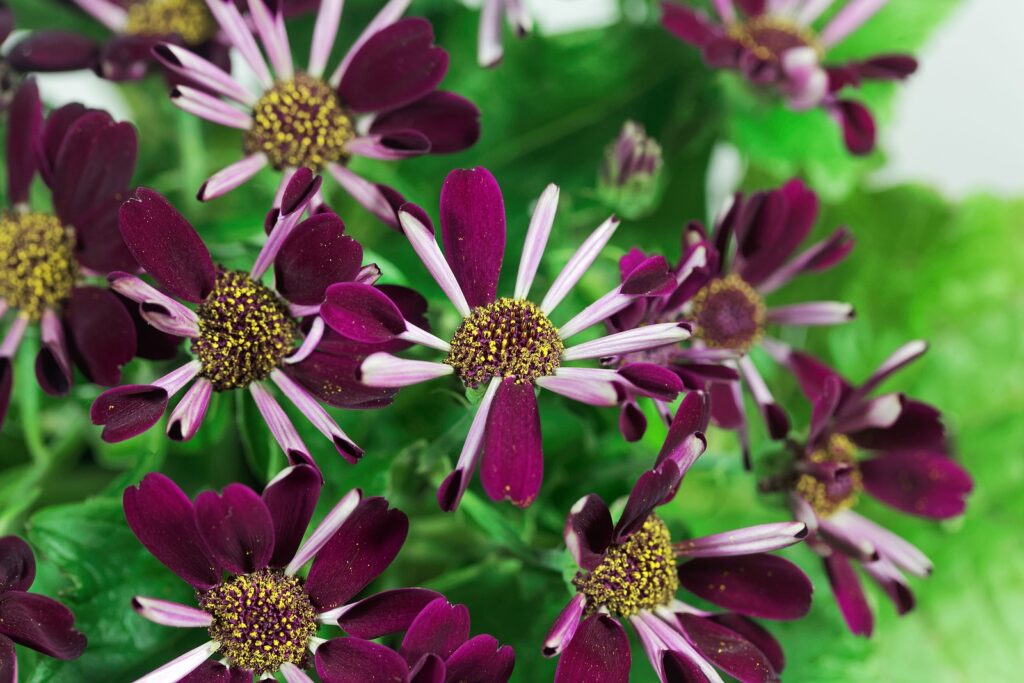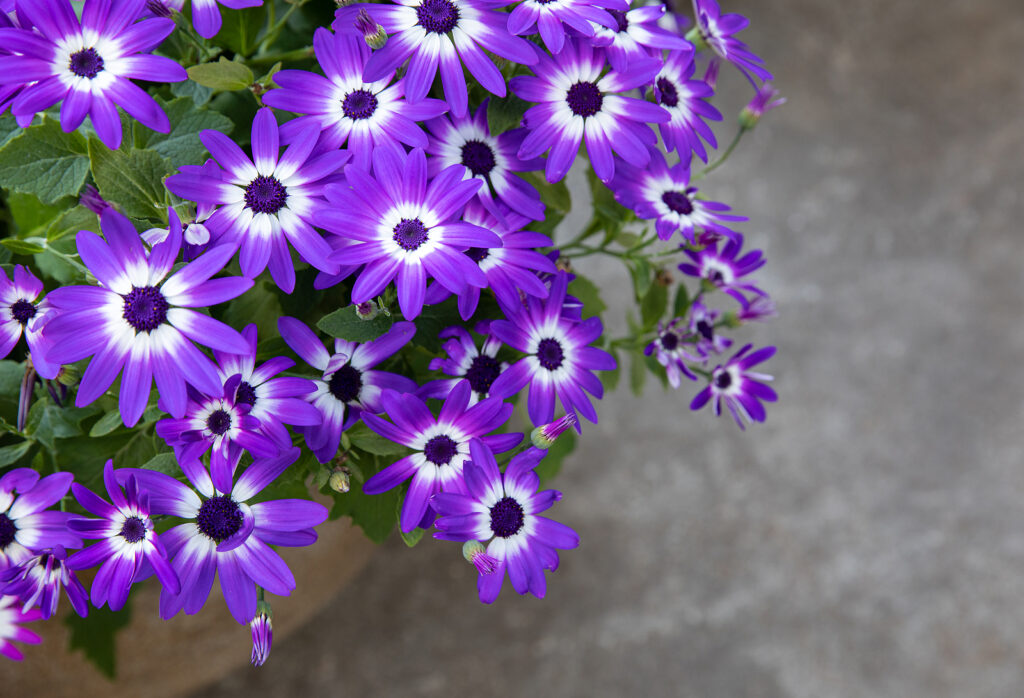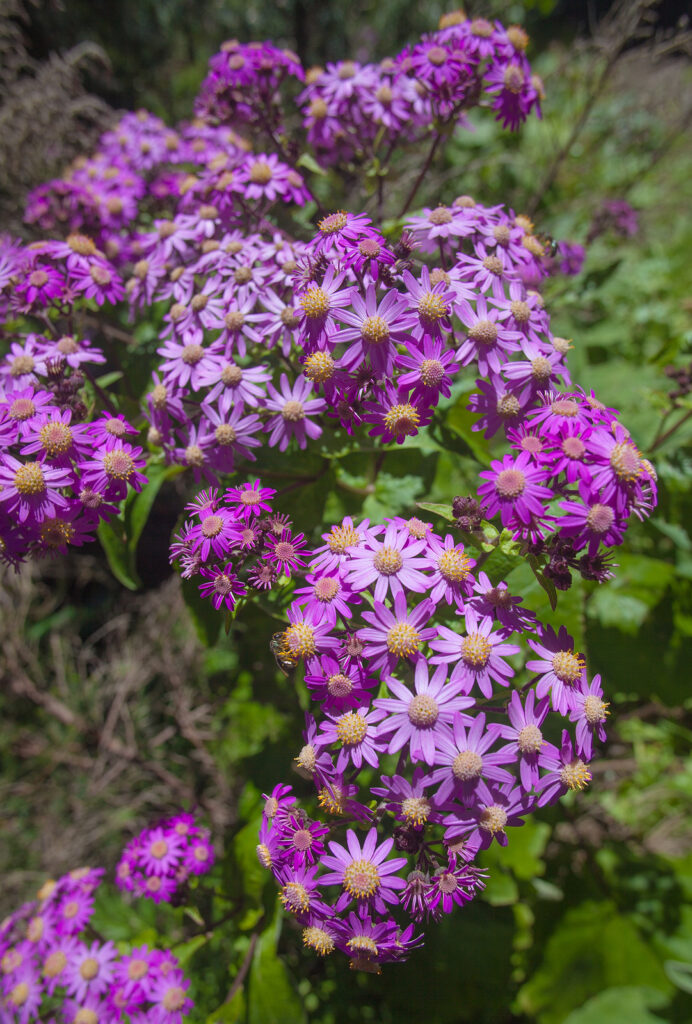Pericallis—commonly known as Florists’ Cineraria–bears a mass of showy flowers each 1 to 2 inches (2.5-5cm) across grouped into a tight, flattish, or slightly domed head that nearly hides the foliage. Flower petals can be blue, maroon, pink, purple, red, or white; they surround a dark center which can be any of these colors.
Pericallis blooms in late winter and early spring. They are commonly sold in full bloom in florists’ shops and garden centers. Most are greenhouse-grown and provide indoor color while the weather outside is still cold.
Pericallis is usually short-lived. It is considered a temporary houseplant. If kept cool and moist the flowering season can extend for several weeks. Once flowers fade, Pericallis is a mass of spent blooms that are all but impossible to deadhead.
Pericallis x hybrida was formerly known as Cineraria x hybridus and so is commonly known as Cineraria.

Get to know Cineraria — Pericallis
- Plant type: Perennial is usually grown as an annual
- Growing zones and range: All zones as an annual; Zones 9-11 as a perennial
- Hardiness: Tender
- Height and width: 24 inches (61cm) tall and wide; dwarf types grow 12 to 15 inches (30-38cm) tall.
- Foliage: Triangular to heart-shaped dark green leaves up to 6 inches (15cm) long; the rough-textured foliage is shallowly lobed and toothed, with downy undersides
- Flowers: Broad clusters of velvety daisy-like flowers, some with contrasting eyes held in domed clusters 3 to 5 inches across.
- Flower colors: White through pink and purplish red to blue and purple, often with contrasting eyes or bands
- Bloom time: Late winter and early spring in mid-winter areas, spring and summer elsewhere
- Uses: Houseplant, greenhouse plant, container plant
- Common name: Florists’ Cineraria
- Botanical name: Pericallis x hybrida, formerly Senecio hybridus
- Family name: Asteraceae
- Origin: Canary Islands
Where to plant Cineraria – Pericallis
- Grow Pericallis in partial or full shade in spring and summer; full light in autumn and winter.
- Grow Pericllis in loose, humus-rich soil.
- Pericallis grows best in a sheltered spot—under shrubs, trees, overhangs, or laths.
Cineraria – Pericallis uses
- Pericallis are well-suited for cool-summer climates. Plant them in beds or borders.
- Pericallis’ bright colors will light up a shady garden.
- Pericallis can be grown in pots and containers and can be set indoors as a flowering houseplant.

When to plant Cineraria – Pericallis
- Sow Pericallis seed in spring for autumn flowering.
- Sow seed in mid to late summer for flowering in late winter and early spring.
Planting and spacing Cineraria – Pericallis
- Sow seed 1/8 inch deep in sterile seed-starting mix; keep the temperature at 60° to 65°F (15.6°-18°C) until seed germinate.
How to water and feed Cineraria – Pericallis
- Pericallis needs regular water.
- Fertilize Pericallis with a liquid fertilizer until buds appear then stop.
Cineraria – Pericallis care
- If Pericallis is kept cool and moist, flowering can be extended several weeks.
Growing Cineraria – Pericallis as a houseplant
- Pericallis x hybrida–called cineraria–is often grown as a houseplant.
- Plance cineraria in a cool room where the light is bright and humidity high.
- Grow in a well-drained, soilless medium and keep it evenly moist.
- Fertilizing is not necessary.
- After the plant has flowered, it will deteriorate and can be discarded.
Cineraria – Pericallis pests and diseases
- Pests include leaf miners, spider mites, slugs, and snails.

Cineraria – Pericallis propagation
- Pericallis is propagated by seed; see above.
- Seeds germinate, uncovered, in 10 to 14 days at 70° to 75°F (21°-24°C).
- Pericallis takes several months to flower from seed.
- Seeds are usually available only in mixed colors.
Cineraria – Pericallis cultivars to grow
- Pericallis x hybrida: dwarf kinds include Multiflora Nana and Hybrida Grandiflora; they grow 12 to 15 inches (30-38cm) tall.
- Cineraria stellata grow 30 to 36 inches (76-91cm) tall with clusters of smaller, star-shaped daisies.
Cineraria – Percallis frequently asked questions
Q: What causes indoor Cineraria leaves to curl and dry at the edges?
A: Indoor cineraria are typically florist plants that rarely last more than 2 to 3 weeks in the average house. Leaves that curl with dry edges are likely the result of indoor temperatures being too hot and dry. The plant is possibly dry at the roots. Indoor cineraria don’t last long when nighttime temperatures are warmer than 45°F.
Q: Can Cinerarias be grown in a south window? Can they be carried over through the summer for flowering again the next fall or winter?
A: Cinerarias are short-lived plants in a warm room. They are grown at 40° to 45°F and never above 50F. They don’t like summer weather. You can place them in a south window in the cool time of the year, but they will likely die in a south window in summer.
Q: Can Cinerarias be grown from seed?
A: Sow cineraria seed in summer to get a sizable plant for winter or early spring. Use very sandy soil and don’t cover the seed starting tray as damping off in hot weather is likely. Sow in late August or early September to avoid the hot days and nights of summer. Keep in mind that cineraria are commonly florist plants and rarely last more than 2 to 3 weeks in the average house.















